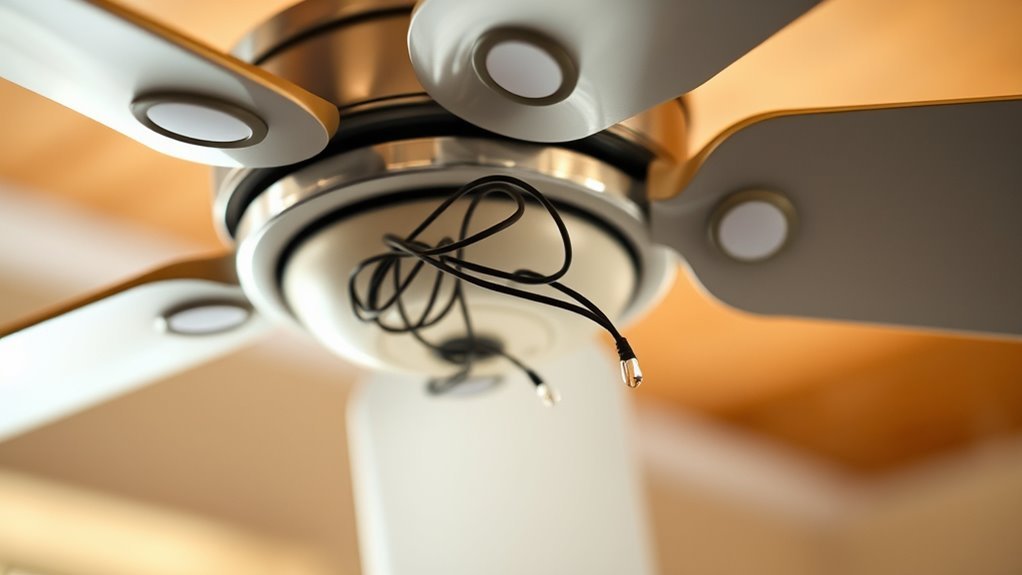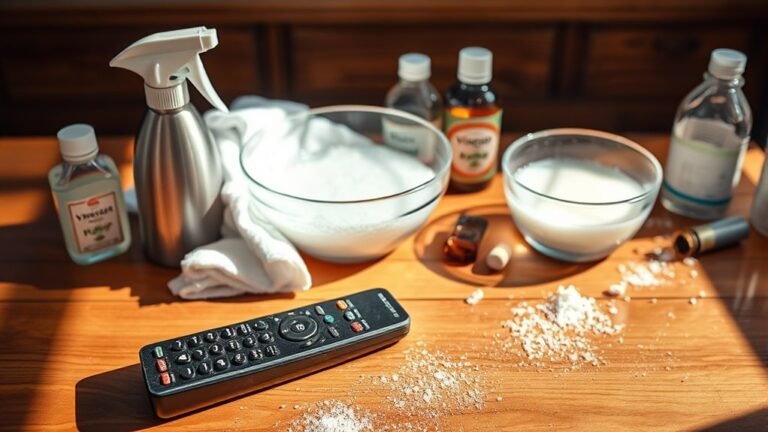Mistakes to Avoid When Cleaning Your Fan
When cleaning your fan, don’t use harsh chemicals or abrasive tools—they can damage surfaces and reduce efficiency. Always unplug the fan first to avoid electric shock, and never ignore the manufacturer’s cleaning instructions, as this could void your warranty. Avoid applying too much water near electrical parts to prevent damage. Regularly clean blades, motor, and vents to maintain airflow. Plus, make sure to reassemble it correctly to keep everything running smoothly. Keep going to discover how to protect your fan best.
Using Harsh Chemicals That Damage Fan Surfaces

When cleaning your fan, you should avoid using harsh chemicals that can damage its surfaces. These aggressive cleaners might promise quick results, but they often strip away protective coatings or cause discoloration, limiting your fan’s lifespan. Instead, opt for gentle chemical alternatives like diluted vinegar solutions or mild soap mixed with water. These choices respect the integrity of your fan’s materials while still effectively removing dust and grime. Protecting your fan’s surface means preserving its look and function, giving you the freedom to enjoy cool breezes without worry. By choosing safer cleaning agents, you’re not just maintaining your fan—you’re embracing a smarter, more responsible way to care for your belongings. Remember, surface protection starts with what you apply, so choose wisely.
Cleaning the Fan Without Unplugging It
You shouldn’t clean your fan without unplugging it first because it puts you at serious risk of electric shock. Leaving it powered can also cause damage to the fan’s internal parts. Always prioritize safety by disconnecting the power before you start cleaning.
Risk of Electric Shock
Although it might seem quicker, cleaning a fan without unplugging it puts you at serious risk of electric shock. Prioritizing electric safety isn’t just about rules—it’s about protecting your freedom to enjoy a safe home. To avoid shocks, always follow these key steps:
- Unplug the fan first—never rely on turning it off; electricity still flows.
- Use dry hands and tools to prevent accidental conduction of electricity.
- Inspect the cord and plug for damage before you start; frayed wires increase shock danger.
Potential Fan Damage
Because fans contain delicate components, cleaning them without unplugging can easily cause damage. If you don’t disconnect the power, you risk accidentally activating the blades or short-circuiting sensitive parts. This careless step can lead to broken fan blades or electrical malfunctions that compromise your fan’s function. Proper fan maintenance means treating your device with care to guarantee its longevity. By unplugging before cleaning, you protect your fan’s motor and wiring, preventing unnecessary wear and tear. Taking this simple precaution keeps your fan running smoothly and extends its lifespan, giving you the freedom to enjoy cool air without frequent repairs or replacements. Remember, respecting your fan’s delicate design is key to maintaining its performance over time.
Safety First Precaution
If you don’t unplug your fan before cleaning, you risk serious injury or damage. Electrical safety isn’t just a suggestion—it’s a must. You want the freedom to clean your fan without worry, so always prioritize safety first. Here’s how to protect yourself:
- Always unplug the fan before starting. This simple step eliminates any chance of electric shock.
- Wear proper safety gear, like gloves and eye protection, to shield yourself from dust and debris.
- Inspect the power cord for damage before plugging it back in to avoid electrical hazards.
Ignoring these precautions could lead to injury or costly repairs. Take control by putting safety first—your freedom to enjoy a clean, safe fan depends on it.
Ignoring the Manufacturer’s Cleaning Instructions
When you skip the manufacturer’s cleaning instructions, you risk damaging your fan or voiding its warranty. Those manufacturer guidelines aren’t just suggestions—they’re tailored to keep your fan running smoothly and safely. Ignoring them might lead you to clean too often or not enough, upsetting the recommended cleaning frequency and potentially harming delicate parts. By sticking to these instructions, you maintain your fan’s freedom to operate at peak performance without unnecessary wear or malfunction. Plus, following the guidelines protects your investment, ensuring you don’t lose warranty coverage because of improper care. Freedom means knowing you’re doing right by your fan, allowing it to last longer and serve you better. So, respect those instructions—they’re your roadmap to hassle-free fan maintenance.
Applying Excessive Water Near Electrical Components

You shouldn’t use too much water near your fan’s electrical parts because it can cause serious damage. Instead, use a damp cloth or specialized cleaners to avoid moisture buildup. Taking these precautions helps keep your fan safe and working properly.
Water Damage Risks
Although cleaning your fan thoroughly is important, applying too much water near its electrical components can cause serious damage. You want to maintain freedom from costly repairs and potential hazards, so mastering moisture control is key. Excessive water exposure can:
- Short-circuit electrical parts, risking permanent damage or even fire hazards.
- Lead to corrosion, gradually degrading the fan’s internal wiring and connections.
- Cause mold growth inside the fan housing, impacting air quality and your health.
Safe Cleaning Techniques
Since electrical components are vulnerable to moisture, it’s essential to clean your fan with care to avoid water damage. Using safe materials and gentle techniques helps keep your fan running smoothly without risking harm. Avoid spraying water directly; instead, opt for damp cloths or specialized electronics wipes. Here’s a quick guide to safe cleaning:
| Area | Recommended Material | Technique |
|---|---|---|
| Blades | Microfiber cloth | Light damp wipe |
| Motor housing | Dry cloth | Gentle dusting |
| Grill | Soft brush | Dry brushing |
| Switches | Electronics wipe | Light dabbing |
| Base | Damp cloth | Controlled wiping |
Stick to these methods, and you’ll maintain your fan’s freedom to cool without risking electrical issues.
Neglecting to Clean Fan Blades Regularly
One common mistake is letting dust and grime build up on your fan blades over time. Ignoring regular fan maintenance not only reduces airflow but also spreads allergens around your space, restricting your freedom to breathe easy. To keep your fan running smoothly and your environment fresh, make cleaning the blades a priority.
Neglecting fan blade cleaning reduces airflow and spreads allergens, hindering your ability to breathe freely.
Here’s why you shouldn’t neglect it:
- Dust buildup adds weight, causing strain on the motor and shortening its life.
- Dirty blades reduce efficiency, forcing the fan to work harder and waste energy.
- Regular cleaning prevents dust from circulating, helping you enjoy cleaner air and more freedom.
Stay on top of fan blade care to keep your space comfortable and your fan performing at its best.
Failing to Remove Dust From Motor and Vents

Dust accumulation inside your fan’s motor and vents can cause serious issues if left unchecked. When dust builds up, it restricts airflow and forces the motor to work harder, leading to overheating and reduced efficiency. Skipping motor maintenance by not cleaning these hidden areas limits your fan’s lifespan and performance. You want your fan to run smoothly and quietly, right? So, take time to carefully remove dust from the vents and motor housing using a soft brush or compressed air. This simple step guarantees ideal airflow and prevents damage caused by overheating. Don’t let dust accumulation rob you of the freedom to enjoy a cool, invigorating breeze. Consistent motor maintenance keeps your fan running freely and efficiently for years to come.
Using Abrasive Tools That Scratch the Fan
Avoid using abrasive tools when cleaning your fan, as they can easily scratch its surface and damage delicate components. You want to preserve your fan’s finish and functionality while enjoying the freedom to clean without worry. Here’s how to avoid pitfalls with abrasive materials:
- Choose soft cloths or microfiber towels to gently wipe the blades and housing.
- Avoid scrub brushes or steel wool that can compromise surface protection and leave permanent marks.
- Use mild cleaning solutions that won’t degrade plastic or metal finishes, keeping your fan looking new.
Reassembling the Fan Incorrectly After Cleaning
If you don’t carefully reassemble your fan after cleaning, it might not work properly or could even become unsafe. Skipping steps or mixing up parts during fan assembly can cause imbalance, noise, or motor strain. To keep your fan running smoothly and safely, follow reassembly tips like aligning blades correctly and securing screws tightly. Don’t rush; take your time to match each piece to its place exactly as it was. Double-check connections and make sure no wires are pinched or loose. When you handle reassembly with care, you maintain your fan’s performance and extend its life, giving you the freedom to enjoy cool, clean air without worry. Avoid shortcuts—proper fan assembly is key to safety and efficiency.
Frequently Asked Questions
How Often Should I Deep Clean My Fan?
You should aim for a cleaning frequency of about every three months to keep your fan running smoothly. Regular fan maintenance not only extends its life but also guarantees better air quality and efficiency. If you use your fan daily or in dusty environments, you might want to deep clean it more often. Staying on top of this lets you enjoy cool, fresh air without hassle, giving you the freedom to relax comfortably all year round.
Can I Use a Vacuum Cleaner to Clean Fan Blades?
Did you know that 70% of fan-related accidents happen during improper cleaning? When it comes to fan maintenance, using a vacuum cleaner on your fan blades can be a quick fix, but you’ve got to be cautious about blade safety. Vacuums might damage delicate blades or loosen screws, risking injury or malfunction. Instead, consider a soft brush attachment or a damp cloth for safer, more effective cleaning that keeps your freedom to enjoy a breeze worry-free.
What Is the Best Way to Dry a Fan After Cleaning?
When it comes to fan drying after cleaning, you’ll want to avoid rushing the process. The best cleaning techniques include gently wiping the blades with a microfiber cloth and letting them air dry fully to prevent moisture buildup. You can also use a dry cloth to speed up drying. Just make sure your fan is completely dry before plugging it back in, so you stay safe and enjoy that fresh, free airflow without worries.
Are There Specific Cleaning Products Recommended for Ceiling Fans?
When cleaning your ceiling fan, you’ll want to stick to safe products that won’t damage the finish or motor. Fan cleaning tips often recommend using mild soap mixed with water or a gentle all-purpose cleaner. Avoid harsh chemicals or abrasive materials—they might ruin your fan’s look or function. You can also grab a microfiber cloth to dust and wipe it down easily. This way, you keep your fan fresh without any worries.
How Do I Maintain Fan Balance After Cleaning?
Imagine your fan blades slicing through the air smoothly, no wobble or hum disturbing your freedom. To maintain balance after cleaning, gently check for fan vibration issues by spinning the blades manually. Use blade alignment tips: guarantee each blade sits evenly and tighten screws without overdoing it. If you spot a misaligned blade, adjust it slightly until the fan spins steady, letting you enjoy that perfect breeze without any annoying shakes.






